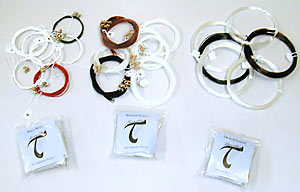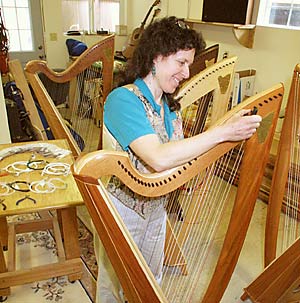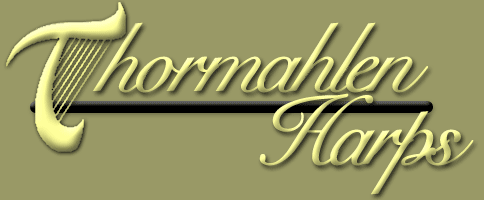|  Strings Strings
Read some suggestions on string
tying and trouble shooting,
and some suggestions on tuning
your harp.
As we wind down our harp building activities, you may
need to know where to purchase strings for your Thormahlen Harp. Here
are the string charts you will need:
Standard Nylon Tension (serial
number 1561 and lower)
Low Tension Nylon Strings (from serial number 1562 and
higher)
Folk/Lever Gut and Concert
Pedal Gut Strings
Fluorocarbon Strings
NYLON is often the best choice for beginners
and those who like the nylon tone and feel. They are easy to keep
in tune, cost less, and are more forgiving of technique.
They have a beautiful tone and a very nice medium tension. We use Thormahlen
bass wires for the lowest octave and a full octave of wound nylon
for the second lowest octave. The transition from bass wires to the
nylon is very gradual and easy on the ears.
LEVER GUT is a light gauge of gut that has a little
softer tension than nylon. It is also called folk harp gut. The tone
is brighter than concert gut but not as bright as nylon. They seem
to be warmer in the lower end and brighter in the higher end. Many
pedal harpists see these strings as a welcome change from concert gut
and a nice rest for their fingers without compromising the wonderfully
warm and rich tone that concert gut offers. Each string is actually
thinner than the corresponding nylon string. We use our bass wires
for the lowest octave.
 CONCERT
GUT is the same stringing used on pedal harps. It has the
warmest tone and the firmest tension. If you are a pedal harp player
and like the feel of your pedal harp, you might choose these strings.
It takes strong fingers to get a lot of sound out of these strings,
so beginners should shy away from them unless you KNOW that you will
play pedal harp someday. The soundboard on concert gut strung harps
are built heavier to accommodate the increased tension of these strings.
We use the same set of bass wires for the lowest octave on
all of our harps. Concert gut strings can only be used on our specially
built concert gut Swan, Cygnet, or Clare model. DO NOT PUT CONCERT
GUT STRINGS ON A HARP BUILT FOR NYLON, LEVER GUT OR FLUOROCARBON.
It will void your warranty and stress your harp. CONCERT
GUT is the same stringing used on pedal harps. It has the
warmest tone and the firmest tension. If you are a pedal harp player
and like the feel of your pedal harp, you might choose these strings.
It takes strong fingers to get a lot of sound out of these strings,
so beginners should shy away from them unless you KNOW that you will
play pedal harp someday. The soundboard on concert gut strung harps
are built heavier to accommodate the increased tension of these strings.
We use the same set of bass wires for the lowest octave on
all of our harps. Concert gut strings can only be used on our specially
built concert gut Swan, Cygnet, or Clare model. DO NOT PUT CONCERT
GUT STRINGS ON A HARP BUILT FOR NYLON, LEVER GUT OR FLUOROCARBON.
It will void your warranty and stress your harp.
FLUOROCARBON strings are made out of a synthetic
polymer. They produce a very bright tone with a very
light tension. The density of these strings are higher than other strings
which makes for a thinner string. These strings do not break often,
and once they are holding pitch, they hold very well. A new string
will tend to stretch quite a bit thus taking some time to tune up to
pitch. They are the most expensive string set.
The Thormahlen Bass Wires are steel-core with a silver
plated copper wrap. We use these bass wires on all of our harps giving
a powerful bass octave that can really be pulled without deflecting
the pitch. The full octave of wires also provides sympathetic vibrations,
which give the entire range of the harp a deep, rich resonance and
more sustain.
- The Swan, Cygnet, and Clare are all available in nylon,
folk gut, concert gut, and fluorocarbon.
- The Serenade and Ceili is available in nylon,
folk gut, and fluorocarbon
strings.
- All of our harps sound great no matter how you string
them!
Please Note: A harp strung in nylon, lever folk
gut or fluorocarbon should never be restrung with concert gut (pedal
harp) strings. The soundboard would not be able to withstand that kind
of tension and the warranty would be void.
In our older Swan, Cygnet and Serenade harps,
before harp #1470, nylon strings and lever gut strings ARE interchangeable
but not with the fluorocarbon strings. There may be a few
lever handles for harps with Loveland levers that may need to be
changed to accommodate the different string gauges. Camac levers
will need to be regulated to the new string gauges. If you need
more information about this, please email or call us.
We have redesigned all of our harps. On our newer harps,
since about harp #1470, nylon, lever gut and fluorocarbon strings ARE
interchangeable. The Camac levers will need to be regulated to the
new string gauges. If you need more information about this, please
email or call us. I have a list of all the harps, so if you are in
question about your harp, email or call and, hopefully, I can give
you the information you need.
To order strings
You can order strings directly from us. Just call or email and let
us know what kind of string you need (concert gut, lever gut, nylon,
or fluorocarbon, the string # and string name. For example "nylon,
string #9 D" or "concert gut 4th octave B (string #23)" and
so forth. The numbers on the concert and lever gut packages will differ
from our numbers but the letter names and thus their colors remain
the same. The numbering system on the gut strings is caused by the
standard set that starts the harp at a first octave E string 2 (36
string harp) or 4 (for a 34 string harp) strings higher than where
our harps begin, so the numbering is off by 2 or 4. The #28 F gut string
is really #26 on our 36 string harp and #24 on our 34 string harp.
It's a little confusing but if you go by the string note name, you
should be fine.
Below are the prices for our individual strings. Complete set prices
are at the bottom of each column):
STRING PRICING CHART
ALWAYS give note name along with the string number (See
the FLUOROCARBON chart below.
Because of the complication of setting up paypal for all
of these individual strings and/or string sets, and so we are sure
you are getting the correct strings, please call us for string orders.
Lyon & Healy have just done a huge price increase.
Their pricing is somewhat confusing. I am willing to help
you with your string order if you would like, but you might want to
just call Lyon
& Healy for Concert Gut or Lever gut strings. The prices below may
not be accurate.
| Note |
Concert Gut |
Lever Gut |
Nylon old/new* |
| 1. C |
nylon $7 |
nylon $7 |
nylon .025/.022 $7 |
| 2. B |
nylon $7 |
nylon $7 |
nylon .025/.022 $7 |
| 3. A |
nylon $7 |
nylon $7 |
nylon .025/.022 $7 |
| 4. G |
nylon $7 |
nylon $7 |
nylon .028/.025 $7 |
| 5. F |
nylon $7 |
nylon $7 |
nylon .028/.025 $7 |
| 6. E |
2nd octave:
Concert Gut $12 #8 |
2nd octave:
Lever Gut $9 #8 |
nylon .028/.025 $7 |
| 7. D |
Concert Gut $12 (#9) |
Lever Gut $9 #9 |
nylon .032/.028 $7 |
| 8. C |
Concert Gut $12 #10 |
Lever Gut $9 #10 |
nylon .032/.028 $7 |
| 9. B |
Concert Gut $12 #11 |
Lever Gut $9 #11 |
nylon .032/.028 $7 |
| 10. A |
Concert Gut $12 #12 |
Lever Gut $12 #12 |
nylon .036/.032 $7 |
| 11. G |
Concert Gut $12 #13 |
Lever Gut $12 #13 |
nylon .036/.032 $7 |
| 12. F |
Concert Gut $12 #14 |
Lever Gut $12 #14 |
nylon .036/.032 $7 |
| 13. E |
3rd octave:
Concert Gut $17 #15 |
3rd octave:
Lever Gut $12 #15 |
nylon .040/.036 $7 |
| 14. D |
Concert Gut $17 #16 |
Lever Gut $12 #16 |
nylon .040/.036 $7 |
| 15. C |
Concert Gut $17 #17 |
Lever Gut $12 #17 |
nylon .040/.036 $7 |
| 16. B |
Concert Gut $17 #18 |
Lever Gut $17 #18 |
nylon .045/.040 $7 |
| 17. A |
Concert Gut $17 #19 |
Lever Gut $17 #19 |
nylon .045/.040 $7 |
| 18. G |
Concert Gut $17 #20 |
Lever Gut $17 #20 |
nylon .045/.045 $7 |
| 19. F |
Concert Gut $17 #21 |
Lever Gut $17 #21 |
nylon .050/.045 $7 |
| 20. E |
4th octave:
Concert Gut $27 #22 |
4th octave:
Lever Gut $17 #22 |
nylon .050/.050 $7 |
| 21. D |
Concert Gut $27 #23 |
Lever Gut $17 #23 |
nylon .050/.055 $7 |
| 22. C middle |
Concert Gut $27 #24 |
Lever Gut $17 #24 |
nylon .055/.055 $7 |
| 23. B |
Concert Gut $27 #25 |
Lever Gut $27 #25 |
Wound nylon $12 |
| 24. A |
Concert Gut $27 #26 |
Lever Gut $27 #26 |
Wound nylon $12 |
| 25. G |
Concert Gut $27 #27 |
Lever Gut $27 #27 |
Wound nylon $12 |
| 26. F |
Concert Gut $27 #28 |
Lever Gut $27 #28 |
Wound nylon $12 |
| 27. E |
5th octave:
Concert Gut $37 #29 |
5th octave:
Lever Gut $27 #29 |
Wound nylon $12 |
| 28. D |
Concert Gut $37 #30 |
Lever Gut $27 #30 |
Wound nylon $12 |
| 29. C |
Concert Gut $37 #31 |
Lever Gut $27 #31 |
Wound nylon $12 |
| 30. B |
---------------Bass Wire $17.50------------------ |
| 31. A |
---------------Bass Wire $17.50------------------ |
| 32. G |
---------------Bass Wire $17.50------------------ |
| 33. F |
---------------Bass Wire $17.50------------------ |
| 34. E |
---------------Bass Wire $17.50------------------ |
| 35. D |
---------------Bass Wire $17.50------------------ |
| 36. C |
---------------Bass Wire $17.50------------------ |
Complete set: |
Concert Gut $660 |
Lever Gut $558 |
Nylon $360 |
| |
|
|
|
| |
|
|
|
| |
|
|
|
| Note |
Savarez Alliance Fluorocarbon |
|
New packaging (2018) KF strings
from Lyon & Healy |
| 1. A45 |
0 oct: FC $6 |
|
A KF FC 1st octave $6** #5 on the
package |
| 2. G45 |
FC $6 |
|
G KF FC 1st octave $6 #6 |
| 3. F47B |
FC $6 |
|
F KF FC 1st octave $6 #7 |
| 4. E47 |
1st oct: $9 |
normally 2nd octave but on the package it says 1st |
E KF FC 2nd octave $9 #8 |
| 5. D52 |
FC $9 |
|
D KF FC 2nd octave $9 #9 |
| 6. C55R |
FC $9 |
|
C KF FC 2nd octave $9 #10 |
| 7. B55 |
FC $9 |
|
B KF FC 2nd octave $9 #11 |
| 8. A57 |
FC $9 |
|
A KF FC 2nd octave $9 #12 |
| 9. G62 |
FC $9 |
|
G KF FC 2nd octave $9 #13 |
| 10. F66B |
FC $9 |
|
F KF FC 2nd octave $9 #14 |
| 11. E 66 |
2 oct: $12.50 |
normally 3rd octave |
E KF FC 3rd octave $12.50 #15 |
| 12. D 69 |
FC $12.50 |
|
D KF FC 3rd octave $12.50 #16 |
| 13. C74R |
FC $12.50 |
|
C KF FC 3rd octave $12.50 #17 |
| 14. B 77 |
FC $12.50 |
|
B KF FC 3rd octave $12.50 #18 |
| 15. A 81 |
FC $12.50 |
|
A KF FC 3rd octave $12.50 #19 |
| 16. G 86 |
FC $12.50 |
|
G KF FC 3rd octave $12.50 #20 |
| 17. F91B |
FC $12.50 |
|
F KF FC 3rd octave $12.50 #21 |
| 18. E91 |
3rd oct: $20 |
normally 4th octave |
E KF FC 4th octave $20 #22 |
| 19. D95 |
FC $20 |
|
D KF FC 4th octave $20 #23 |
| 20.C101R |
FC $20 mid C |
|
C KF FC 4th octave $20 #24 |
| 21. B105 |
FC $20 |
|
Savarez FC packaging from here |
| 22. A108 |
FC $20 |
|
|
| 23. G121 |
FC $20 |
|
|
| 24.F127B |
FC $20 |
|
|
| 25. E140 |
4th oct: $30 |
normally 5th octave |
|
| 26. D150 |
FC $30 |
|
|
| 27.C160R |
FC $30 If your harp is
older, this string may be a Dusty
Strings Ravenna #27 C Bass Wire |
| 28. B |
Bass Wire $17.50---(labeled
#30 in the string set) |
| 29. A |
Bass Wire $17.50---(#31) |
| 30. G |
Bass Wire $17.50---(#32) |
| 31. F |
Bass Wire $17.50---(#33) |
| 32. E |
Bass Wire $17.50---(#34) |
| 33. D |
Bass Wire $17.50---(#35) |
| 34. C |
Bass Wire $17.50---(#36) |
Complete set: |
Fluorocarbon $520 |
Short set for 34 string Ceili: $112.50 which includes
strings down to 3rd octave C
Short set for 36 string Serenade: $118.50 which includes
strings down to 3rd octave C |
*Since harp #1562, all nylon harps have the new stringing.
**We found a new source of fluorocarbon strings that match our
gauges down to middle C and are using them from now on. But the
old source will still be used for the lower strings below middle
C to the bass wires.
|
| |
|
|
|

For a couple of side trips take a look at some suggestions
on string tying and trouble shooting
and some suggestions on tuning your harp.
 To
continue on the journey, find out more About
Harps in general. This is a very brief history. You'll also find
a "Parts of a Harp" diagram at the bottom of that page. To
continue on the journey, find out more About
Harps in general. This is a very brief history. You'll also find
a "Parts of a Harp" diagram at the bottom of that page.
|

 Strings
Strings CONCERT
GUT is the same stringing used on pedal harps. It has the
warmest tone and the firmest tension. If you are a pedal harp player
and like the feel of your pedal harp, you might choose these strings.
It takes strong fingers to get a lot of sound out of these strings,
so beginners should shy away from them unless you KNOW that you will
play pedal harp someday. The soundboard on concert gut strung harps
are built heavier to accommodate the increased tension of these strings.
We use the same set of bass wires for the lowest octave on
all of our harps. Concert gut strings can only be used on our specially
built concert gut Swan, Cygnet, or Clare model. DO NOT PUT CONCERT
GUT STRINGS ON A HARP BUILT FOR NYLON, LEVER GUT OR FLUOROCARBON.
It will void your warranty and stress your harp.
CONCERT
GUT is the same stringing used on pedal harps. It has the
warmest tone and the firmest tension. If you are a pedal harp player
and like the feel of your pedal harp, you might choose these strings.
It takes strong fingers to get a lot of sound out of these strings,
so beginners should shy away from them unless you KNOW that you will
play pedal harp someday. The soundboard on concert gut strung harps
are built heavier to accommodate the increased tension of these strings.
We use the same set of bass wires for the lowest octave on
all of our harps. Concert gut strings can only be used on our specially
built concert gut Swan, Cygnet, or Clare model. DO NOT PUT CONCERT
GUT STRINGS ON A HARP BUILT FOR NYLON, LEVER GUT OR FLUOROCARBON.
It will void your warranty and stress your harp.